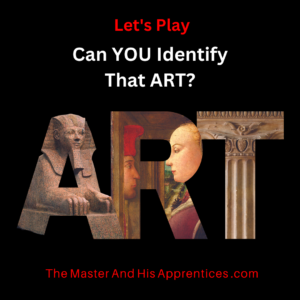Let’s Play an Art History Game Called “Can you Identify That Art?”
Can You Guess All 10 Pieces Correctly?
Do you like art history games? If you enjoy visiting art museums, have an interest in art history, or have read The Master and Apprentices: Art History from a Christian Perspective, then YOU may be able to guess all 10 pieces correctly!
In The Old Schoolhouse Spring Magazine, we have an ad on page 117 that includes the words “ART HISTORY.” Each letter features a different work of art. Can you identify the period for each piece? Can you provide a title and artist, if applicable, in our art history game?
Only 2 of these specific 10 images are shown in the textbook. However, once you have learned the style for a particular period or artist, it makes identifying similar works much easier!
The included images are from The Met’s collection in New York City. The Met is the largest and most visited art museum in the United States (where most of our readers live). So, this also provides a good overview of pieces you can view if your family has a chance to visit!
Let’s Play “Can YOU Identify That Art?”

To play this art history game, fill in the spaces below with relevant details for each corresponding letter image. These may include but are not limited to the period, style, material, theme, artist, title, usage, and technique.
A
R
T
H
I
S
T
O
R
Y
Answer Key
So, how did it go? Could you identify as many as you had hoped and provide relevant details? Each piece’s period, artist, and/or title are listed below. Furthermore, page numbers for The Master and His Apprentices textbook AND a link to the Met’s page for each piece are included. Consequently, you can read more and see if you were able to provide any additional correct details.
ART
- A This particular ancient Egyptian sculpture is not included in the textbook. However, readers may be able to make an educated guess that this piece depicts Queen Hatshepsut based on the images included of her on pages 70-71. https://www.metmuseum.org/art/collection/search/544442
- R This Early Italian Renaissance painting, Portrait of a Woman with a Man at a Casement (also Man and Woman at a Casement), by Filippo Lippi. Is included in the textbook on page 233. https://www.metmuseum.org/art/collection/search/436896
- T This particular ancient Greek column is not included in the textbook. However, students may be able to make an educated guess that this is an Ionic column based on the partial view of the capital, as discussed on pages 104-105. https://www.metmuseum.org/art/collection/search/252453
HISTORY
- H This particular African plaque by an Edo artist for the Court of Benin is not included in the textbook. However, readers may be able to identify the period and origin based on a similar piece shown on page 315. https://www.metmuseum.org/art/collection/search/316393
- I This particular ancient Egyptian cylinder seal (very similar to Ancient Near East seals) is not included in the textbook. Nevertheless, students should be able to recall the usage and construction methods for the multitude of cylinder seals found throughout the Mesopotamian region as shown on pages 36-37. https://www.metmuseum.org/art/collection/search/557024
- S This particular Byzantine-period mosaic is not included in the textbook. However, readers should be able to identify the period based on the other mosaics shown on pages 150-151. https://www.metmuseum.org/art/collection/search/469960
- T This particular Ancient Roman bust of Emperor Caracalla is not included in the textbook. However, viewers should be able to identify the period based on the busts included on pages 118, 138-139. https://www.metmuseum.org/art/collection/search/253592
- O This Northern Renaissance (Netherlandish) painting by Robert Campin, titled the Mérode Altarpiece, is shown in the textbook on page 268. https://www.metmuseum.org/art/collection/search/470304
- R This particular Romanesque-style arch is not included in the textbook. Nevertheless, students should be able to identify the period based on the rounded (vs.Gothic pointed) arch from the info and pictures on pages 174-177. https://www.metmuseum.org/art/collection/search/471179
- Y This particular Ancient Near East (Babylonian) glazed brick mosaic from the Processional Way to the Ishtar Gate is not included in the textbook. However, readers should be able to identify it based on the images shown on pages 46-47. https://www.metmuseum.org/art/collection/search/322585
The Master and His Apprentices Textbook
If you haven’t read it already, The Master and His Apprentices: Art History from a Christian Perspective textbook covers all of the major Western Art History periods from Creation and Ancient Times through the Renaissance and Baroque periods (including a summary of Non-Western and Modern/Contemporary art). Used with the companion Teacher Guide, the homeschool art history curriculum provides a FULL high school elective credit.
Thank you for playing our art history game. We hope you enjoyed “Can You Identify that Art?”!
